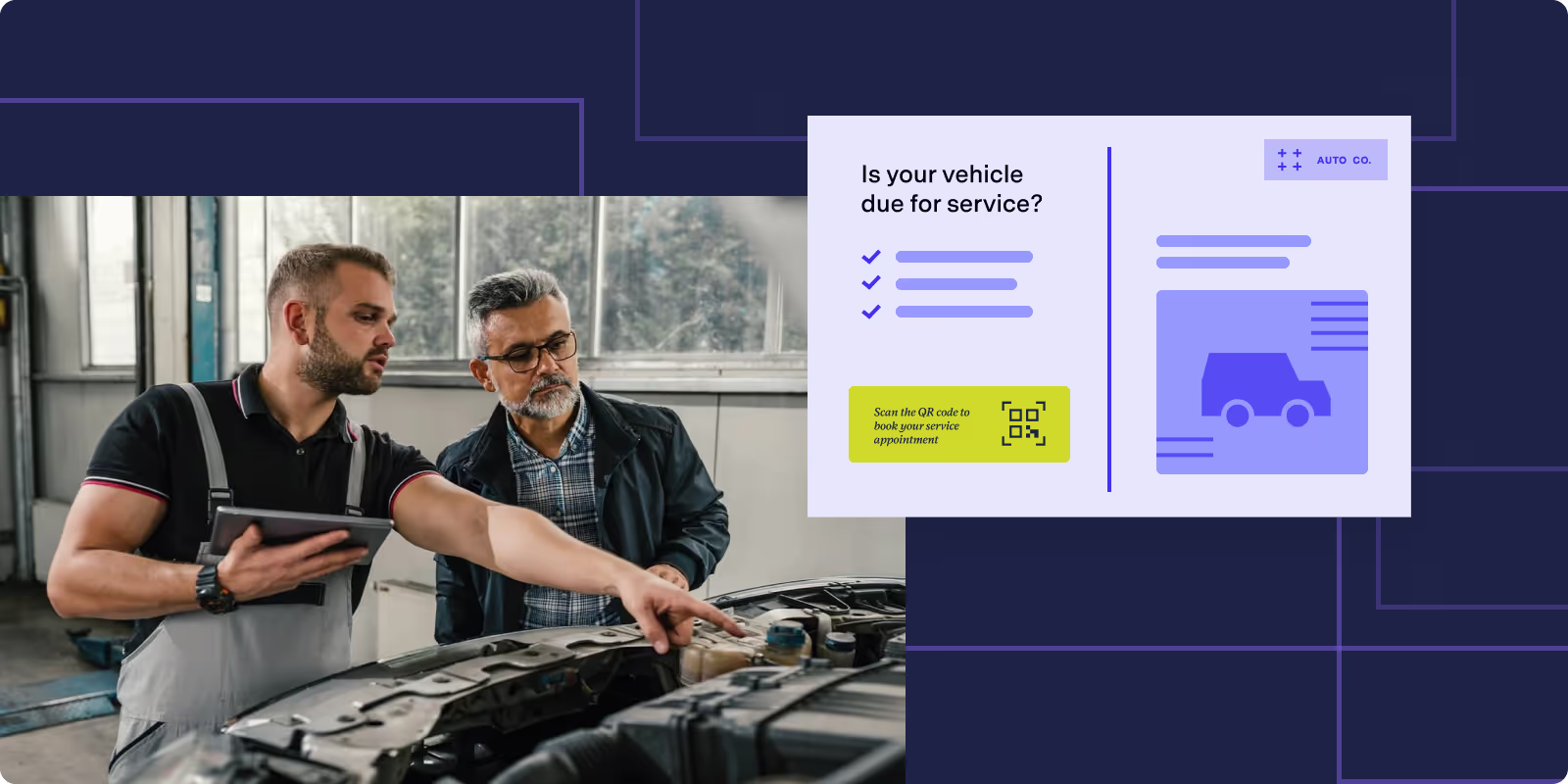


By
Lob
Automotive businesses are discovering what smart marketers already know: direct mail is having a moment. While digital channels get crowded and expensive, direct mail cuts through the noise with results that speak for themselves.
This guide explains the role of direct mail in automotive marketing, how it works, who uses it, and why it continues to have a measurable impact.
Whether you’re sending promotions for a dealership event or reminders for service appointments, direct mail offers a physical way to connect with customers. With Lob, automotive marketers use it across the customer lifecycle, from acquisition to loyalty.
Automotive direct mail marketing uses printed mail to reach customers of car dealerships, repair shops, parts retailers, and vehicle finance providers. These mailpieces can include postcards, brochures, letters, or folded self-mailers delivered through the postal system.
Unlike digital ads, automotive direct mail often includes vehicle purchase details, service offers, warranties, seasonal promotions, or loyalty incentives. Recipients might get a postcard with their vehicle’s service history, a letter about lease-end options, or a brochure featuring new models at a local dealership.
According to USPS data, automotive companies dedicate a significant portion of their media budgets to direct mail, with investments spread across both existing customers and new customer acquisition.
Popular formats include:
Direct mail supports every stage of the customer journey, from awareness and interest to purchase, loyalty, and win-back strategies.
Direct mail gives automotive brands a way to stand out in a crowded digital world. When inboxes are full and social feeds are packed with ads, a physical mailpiece gets noticed.
Higher engagement: Direct mail gets opened and read. Most recipients, including Millennials, sort through their mail to avoid missing important information. Physical mail requires handling, which increases the chance your message gets seen.
Targeting precision: With Lob, you can send offers to specific neighborhoods or target customers by vehicle type and service history. A repair shop might reach Honda owners within five miles of their location. A dealership could mail lease-end notices to customers whose terms expire in 60 days.
Trust building: Consumers often trust direct mail more than digital messages, and they tend to express fewer privacy concerns about mail compared to email and online ads.
Complementary to digital: Direct mail works best alongside your online marketing. Automotive marketers often coordinate mailings with email, digital ads, and website content.
Direct mail response rates are consistently higher than those for email, paid search, or social media ads.
Essential formats for automotive direct mail campaigns
Postcards are the workhorses of automotive direct mail — flat, single-sheet mailpieces that don’t need an envelope and are instantly visible.
Dealerships and repair shops use postcards for:
Postcards are cost-effective, quick to produce, and ensure your message is seen without being opened.
Letters work when your message needs more detail or a personal touch. They’re used for:
With Lob’s variable data printing, you can personalize letters with the recipient’s name, vehicle details, mileage milestones, and service history.
Brochures and catalogs give you room to showcase multiple vehicles, service packages, or parts collections. They’re ideal for:
Include QR codes or personalized URLs to connect readers to virtual test drives or interactive tools.
Lob’s automation and variable data printing let you personalize every mailpiece:
Pairing Lob’s direct mail with digital marketing creates a seamless customer experience:
Track by goal:
Use Lob’s tracking features — QR codes, personalized URLs, and unique phone numbers — to connect mail to customer actions.
Avoiding common pitfalls
With Lob, automotive direct mail is automated, personalized, and measurable. You can trigger campaigns from real-time customer data, integrate with your existing tools, and connect mail to digital actions.
A national dealership group used Lob to automate lease-end letters at set intervals. Each piece included personalized financing options and a QR code for booking trade-in assessments. The result? Test drive bookings increased significantly year-over-year.
Ready to transform your automotive marketing? Book a demo to see how Lob can help you create high-impact direct mail campaigns.
Frequently asked questions about automotive direct mail
FAQs

How much does an automotive direct mail campaign typically cost?
Automotive direct mail campaign costs vary depending on format, quantity, and level of personalization, with most dealerships and repair shops investing a set budget per campaign.
How can automotive businesses measure direct mail campaign effectiveness?
Track response rates using dedicated phone numbers, QR code scans, promo code redemptions, and appointment bookings, then calculate ROI by comparing campaign costs to revenue generated from customer actions.
What makes direct mail more effective than digital marketing for automotive companies?
Direct mail achieves higher response rates (5-9% vs. 1% for digital) because it's tangible, faces less competition for attention, and creates stronger trust, especially for high-consideration purchases like vehicles and services.
How can auto repair shops use direct mail for customer retention?
Send service reminders based on mileage or time intervals, create seasonal maintenance offers, implement loyalty programs with point-tracking postcards, and mail personalized thank-you notes after service visits.
How often should automotive businesses send direct mail to their customers?
Many automotive businesses find success with a steady rhythm of service reminders, seasonal promotions, and special offers, while avoiding over-mailing which can lead to customer fatigue.